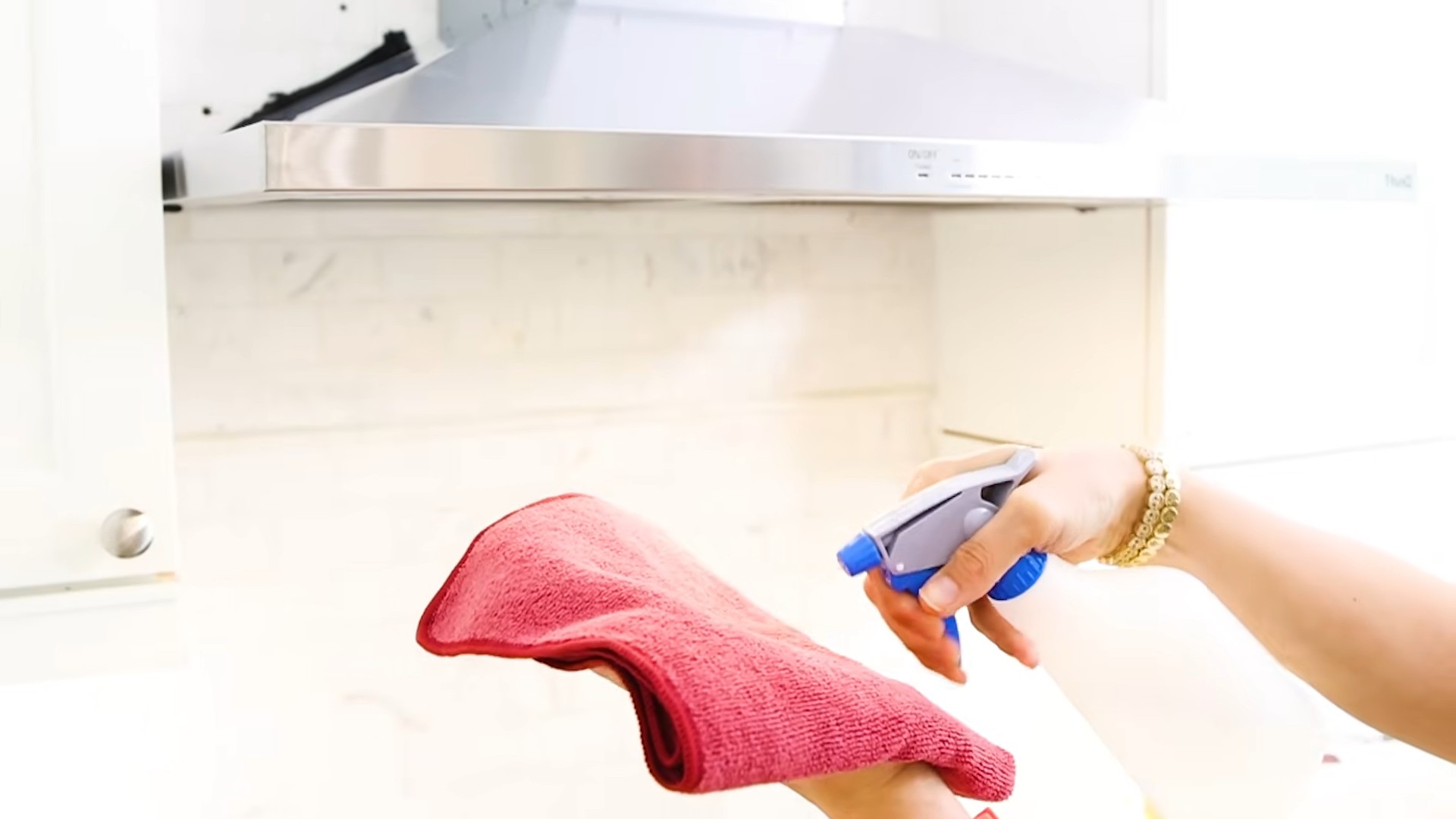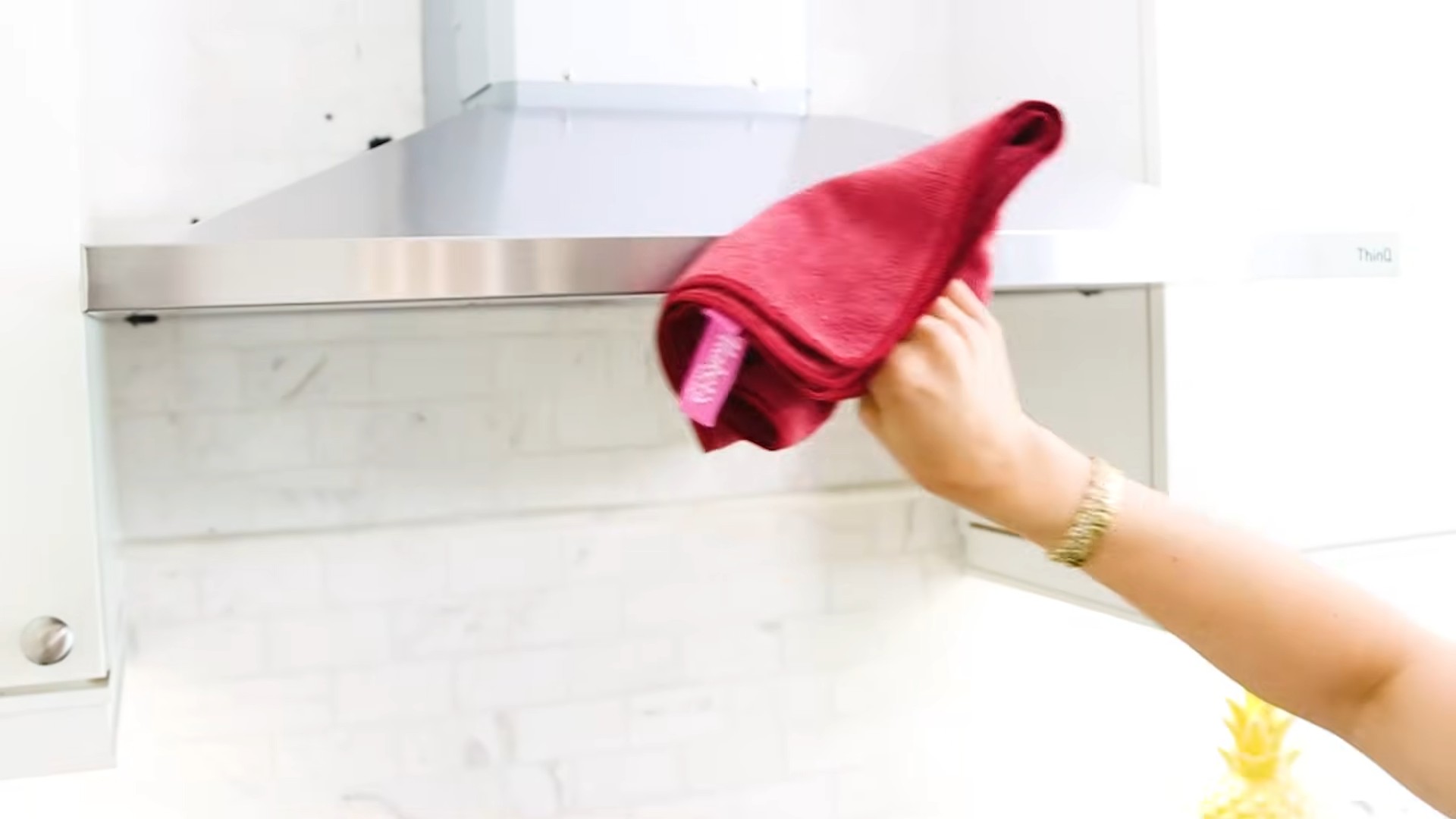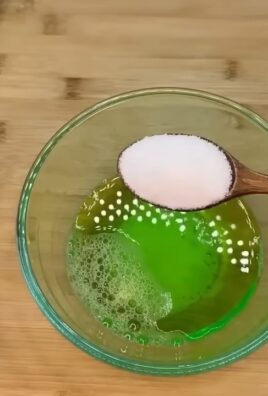Homemade stainless steel cleaner – sounds too good to be true, right? I get it! You’re probably staring at those smudged fingerprints and stubborn water spots on your stainless steel appliances, thinking only harsh chemicals can restore their shine. But what if I told you that the secret to sparkling, streak-free stainless steel is likely already hiding in your pantry?
For generations, resourceful homemakers have relied on simple, natural ingredients to keep their homes clean and gleaming. Before the age of mass-produced cleaning products, vinegar, baking soda, and lemon juice were the go-to solutions for everything from scrubbing floors to polishing silverware. This tradition of resourcefulness is not just about saving money; it’s about minimizing our impact on the environment and creating a healthier home for ourselves and our families.
Let’s face it, commercial stainless steel cleaners can be expensive and often contain harsh chemicals that you might not want lingering around your kitchen. Plus, who wants to run to the store every time a smudge appears? That’s where this DIY trick comes in! I’m going to show you how to whip up your own effective homemade stainless steel cleaner using ingredients you probably already have. This simple recipe will not only save you money but also give you peace of mind knowing exactly what you’re using to clean your precious appliances. Get ready to say goodbye to streaks and hello to a brilliantly shiny kitchen!

DIY Stainless Steel Cleaner: Make Your Kitchen Shine!
Hey everyone! Are you tired of those expensive stainless steel cleaners that promise the world but leave streaks and fingerprints behind? Well, I’ve got a fantastic solution for you: a homemade stainless steel cleaner that’s not only incredibly effective but also super affordable and eco-friendly. I’ve been using this recipe for years, and my stainless steel appliances have never looked better!
Why Make Your Own Stainless Steel Cleaner?
Before we dive into the recipe, let’s talk about why making your own cleaner is a great idea:
* Cost-Effective: You probably already have most of the ingredients in your pantry.
* Eco-Friendly: You’re reducing your reliance on harsh chemicals and plastic packaging.
* Effective: This cleaner works just as well, if not better, than store-bought options.
* Customizable: You can adjust the recipe to suit your specific needs and preferences.
* Safe: You know exactly what’s going into your cleaner, avoiding potentially harmful chemicals.
What You’ll Need
Okay, let’s gather our supplies. Here’s what you’ll need to create this amazing stainless steel cleaner:
* 1 cup of white vinegar
* 1 cup of water (distilled water is best, but tap water works too)
* 2 tablespoons of dish soap (I prefer a gentle, unscented variety)
* 1 tablespoon of olive oil (for polishing)
* A clean spray bottle
* Two microfiber cloths (one for cleaning, one for polishing)
* Optional: A few drops of your favorite essential oil (lemon, lavender, or tea tree are great choices for their cleaning properties and pleasant scents)
Step-by-Step Instructions
Now, let’s get down to business! Here’s how to make and use your homemade stainless steel cleaner:
1. Prepare the Cleaning Solution: In a mixing bowl or large measuring cup, combine the white vinegar, water, and dish soap. Stir gently to avoid creating excessive bubbles. If you’re using essential oils, add a few drops now. I usually go for about 5-10 drops, depending on the strength of the oil.
2. Transfer to Spray Bottle: Carefully pour the mixture into your clean spray bottle. Make sure the bottle is properly labeled to avoid any confusion later on. I like to write “Stainless Steel Cleaner” on mine with a permanent marker.
3. Prepare the Surface: Before you start spraying, give your stainless steel surface a quick wipe with a dry microfiber cloth to remove any loose dirt or debris. This will prevent you from just spreading the grime around.
4. Spray and Wipe: Lightly spray the stainless steel surface with your homemade cleaner. Don’t over-saturate it; a light mist is all you need. Let the cleaner sit for a minute or two to loosen any stubborn grime.
5. Wipe Clean: Using a clean microfiber cloth, wipe the surface in the direction of the grain. This is crucial for preventing streaks. Pay attention to the direction of the grain, which usually runs horizontally or vertically.
6. Polish with Olive Oil: This is where the magic happens! Pour a very small amount of olive oil (about a teaspoon) onto a clean, dry microfiber cloth. Rub the cloth together to distribute the oil evenly.
7. Buff to a Shine: Gently buff the stainless steel surface with the olive oil-treated cloth, again following the grain. You’ll be amazed at how the olive oil brings out the shine and helps to protect the surface from fingerprints.
8. Remove Excess Oil (If Needed): If you’ve used too much olive oil and the surface feels greasy, use a clean, dry microfiber cloth to buff away any excess.
Dealing with Stubborn Stains
Sometimes, you’ll encounter stubborn stains that require a little extra attention. Here are a few tips for tackling those tough spots:
* Baking Soda Paste: For baked-on food or water spots, make a paste of baking soda and water. Apply the paste to the stain, let it sit for a few minutes, and then gently scrub with a soft cloth or sponge. Rinse with water and dry thoroughly.
* Vinegar Soak: For hard water stains, soak a paper towel in white vinegar and place it over the stain for about 30 minutes. Then, wipe clean and dry.
* Lemon Juice: Lemon juice is a natural degreaser and can be effective for removing grease splatters. Apply lemon juice to the stain, let it sit for a few minutes, and then wipe clean.
Tips for Maintaining Your Stainless Steel
Here are some tips to keep your stainless steel looking its best:
* Wipe Up Spills Immediately: The longer spills sit on stainless steel, the harder they are to remove.
* Avoid Abrasive Cleaners: Abrasive cleaners can scratch the surface of stainless steel.
* Dry Thoroughly: Always dry your stainless steel after cleaning to prevent water spots.
* Regular Cleaning: Clean your stainless steel appliances regularly to prevent buildup of dirt and grime. I usually clean mine once a week.
Specific Applications
Let’s look at how to use this cleaner on different stainless steel items:
Cleaning Stainless Steel Appliances
This cleaner works wonders on refrigerators, dishwashers, ovens, and microwaves. Just follow the steps above, paying close attention to the grain of the metal. For ovens, make sure the surface is cool before cleaning.
Cleaning Stainless Steel Sinks
Stainless steel sinks can be prone to water spots and food stains. Use the baking soda paste or vinegar soak method for stubborn stains. Rinse thoroughly after cleaning.
Cleaning Stainless Steel Cookware
This cleaner can also be used on stainless steel pots and pans. For burnt-on food, try soaking the cookware in hot, soapy water before cleaning.
Troubleshooting
Here are some common problems you might encounter and how to solve them:
* Streaks: Streaks are usually caused by wiping against the grain or using too much cleaner. Make sure you’re wiping in the direction of the grain and using a clean, dry microfiber cloth.
* Greasy Residue: If you’re using too much olive oil, you might end up with a greasy residue. Use a clean, dry microfiber cloth to buff away any excess oil.
* Lingering Odor: If you’re sensitive to the smell of vinegar, add a few drops of your favorite essential oil to the cleaner.
Safety Precautions
While this cleaner is made with natural ingredients, it’s still important to take some safety precautions:
* Avoid Contact with Eyes: If the cleaner gets in your eyes, rinse immediately with plenty of water.
* Keep Out of Reach of Children: Store the cleaner in a safe place, out of reach of children and pets.
* Test on a Small Area: Before cleaning a large surface, test the cleaner on a small, inconspicuous area to make sure it doesn’t damage the finish.
Variations and Customizations
Feel free to experiment with different variations of this recipe to find what works best for you:
* Lemon Juice: Replace some of the vinegar with lemon juice for extra degreasing power.
* Castile Soap: Use castile soap instead of dish soap for a more natural option.
* Borax: Add a tablespoon of borax to the cleaner for extra cleaning power. However, be careful when using borax, as it can be irritating to the skin.
Storage
Store your homemade stainless steel cleaner in a cool, dark place. It should last for several months. Just give it a good shake before each use.
Final Thoughts
I hope you found this guide helpful! Making your own stainless steel cleaner is a simple and rewarding way to keep your kitchen looking its best. Plus, you’ll save money and reduce your environmental impact. Give it a try, and let me know what you think! Happy cleaning!

Conclusion
So, there you have it! Ditching the harsh chemicals and embracing this simple, effective, and budget-friendly homemade stainless steel cleaner is a game-changer for your kitchen and beyond. We’ve shown you how easy it is to whip up a batch using ingredients you likely already have in your pantry. Forget those expensive, store-bought cleaners that promise the world but often leave streaks and a lingering chemical odor. This DIY solution delivers a sparkling, streak-free shine without the hefty price tag or the environmental concerns.
But why is this homemade stainless steel cleaner a must-try? It’s more than just a cleaning solution; it’s a commitment to a healthier home and a more sustainable lifestyle. You’re reducing your exposure to potentially harmful chemicals, minimizing plastic waste from disposable bottles, and saving money in the process. Plus, the satisfaction of creating something effective with your own two hands is incredibly rewarding.
Beyond the basic recipe, there’s room for experimentation and personalization. For a boost of extra cleaning power, consider adding a few drops of your favorite essential oil, like lemon or tea tree, known for their antibacterial properties. If you’re dealing with stubborn hard water stains, try pre-treating the area with a paste of baking soda and water before applying the cleaner. And for those extra-grimy surfaces, a gentle scrub with a microfiber cloth or a soft-bristled brush can work wonders.
Don’t limit this cleaner to just your kitchen appliances! It’s fantastic for stainless steel sinks, cookware, bathroom fixtures, and even outdoor grills (just be sure to rinse thoroughly). The versatility of this homemade solution makes it an indispensable addition to your cleaning arsenal.
We wholeheartedly encourage you to give this homemade stainless steel cleaner a try. We’re confident that you’ll be amazed by the results. Once you’ve experienced the sparkling shine and the peace of mind that comes with using a natural cleaner, you’ll never go back to store-bought alternatives.
But don’t just take our word for it! We want to hear about your experiences. Share your before-and-after photos, your variations on the recipe, and any tips or tricks you discover along the way. Let’s build a community of DIY cleaning enthusiasts who are passionate about creating a cleaner, healthier, and more sustainable world, one sparkling stainless steel surface at a time. Head over to the comments section and tell us all about your homemade stainless steel cleaner adventures! We can’t wait to hear from you.
Frequently Asked Questions (FAQ)
What exactly makes this homemade stainless steel cleaner so effective?
The effectiveness of this cleaner lies in the synergistic action of its simple ingredients. Vinegar, a mild acid, helps to dissolve grease, grime, and hard water stains. The dish soap acts as a surfactant, reducing the surface tension of the water and allowing the cleaner to penetrate dirt and lift it away. The water itself dilutes the mixture, making it safe for use on stainless steel surfaces and preventing streaks. Together, these ingredients create a powerful yet gentle cleaning solution that effectively removes dirt and leaves a streak-free shine.
Is this homemade cleaner safe for all types of stainless steel?
Generally, yes, this cleaner is safe for most types of stainless steel. However, it’s always a good idea to test it on a small, inconspicuous area first, especially if you’re unsure about the type of stainless steel you’re dealing with. Avoid using abrasive scrubbers or steel wool, as these can scratch the surface. For brushed stainless steel, always wipe in the direction of the grain to prevent damage. If you have any concerns, consult the manufacturer’s instructions for your specific appliance or fixture.
Can I use a different type of vinegar, like apple cider vinegar, instead of white vinegar?
While white vinegar is the preferred choice due to its higher acidity and lack of color, you can use apple cider vinegar as a substitute. However, be aware that apple cider vinegar has a slightly lower acidity level, so it may not be as effective at removing stubborn stains. It also has a brownish tint, which could potentially leave a slight residue on lighter-colored stainless steel. If you choose to use apple cider vinegar, be sure to rinse the surface thoroughly after cleaning.
How often should I use this homemade stainless steel cleaner?
The frequency of cleaning depends on how often your stainless steel surfaces are used and how dirty they get. For frequently used appliances like refrigerators and dishwashers, a weekly cleaning is generally sufficient. For less frequently used items, such as decorative stainless steel accents, cleaning every few weeks or months may be enough. Regular cleaning will prevent the buildup of dirt and grime, making it easier to maintain a sparkling shine.
What if I don’t have dish soap? Can I use something else?
While dish soap is the preferred surfactant, you can substitute it with a small amount of another mild liquid soap, such as hand soap or castile soap. However, be sure to use a very small amount, as these soaps can sometimes leave a residue. Avoid using soaps that contain harsh chemicals or abrasives, as these can damage the stainless steel surface. If you’re using a different type of soap, test it on a small, inconspicuous area first to ensure that it doesn’t leave any streaks or residue.
How do I prevent streaks when using this cleaner?
Streaks are often caused by using too much cleaner or not drying the surface properly. To prevent streaks, use a light hand when applying the cleaner and wipe the surface with a clean, dry microfiber cloth immediately after cleaning. Wiping in the direction of the grain of the stainless steel can also help to prevent streaks. If you’re still experiencing streaks, try diluting the cleaner with more water or using a different type of microfiber cloth.
Can I store the leftover cleaner? If so, how long will it last?
Yes, you can store the leftover cleaner in a spray bottle or other airtight container. It will typically last for several months without losing its effectiveness. However, it’s best to store it in a cool, dark place to prevent the vinegar from evaporating. Before each use, give the bottle a gentle shake to ensure that the ingredients are well combined. If you notice any changes in the color or odor of the cleaner, it’s best to discard it and make a fresh batch.
Is this cleaner safe to use around children and pets?
This homemade stainless steel cleaner is generally considered safe to use around children and pets, as it’s made with non-toxic ingredients. However, it’s still important to keep the cleaner out of reach of children and pets to prevent accidental ingestion. If ingested, the cleaner may cause mild irritation to the mouth and throat. If you have any concerns, consult with your pediatrician or veterinarian.
My stainless steel has stubborn hard water stains. Will this cleaner remove them?
This cleaner can help to remove mild hard water stains. For more stubborn stains, try pre-treating the area with a paste of baking soda and water. Apply the paste to the stain, let it sit for a few minutes, and then gently scrub with a soft cloth or sponge. Rinse thoroughly with water and then apply the homemade stainless steel cleaner as directed. For extremely stubborn hard water stains, you may need to use a commercial hard water stain remover.
Can I add essential oils to this cleaner? What are the best essential oils to use?
Yes, you can add a few drops of essential oils to this cleaner for added fragrance and antibacterial properties. Some of the best essential oils to use include lemon, tea tree, lavender, and eucalyptus. Lemon essential oil is known for its degreasing and disinfecting properties, while tea tree oil is a powerful antibacterial and antifungal agent. Lavender oil has a calming scent and also possesses antibacterial properties. Eucalyptus oil has a refreshing scent and can help to remove stubborn stains. When adding essential oils, use only a few drops, as too much can leave a residue.




Leave a Comment